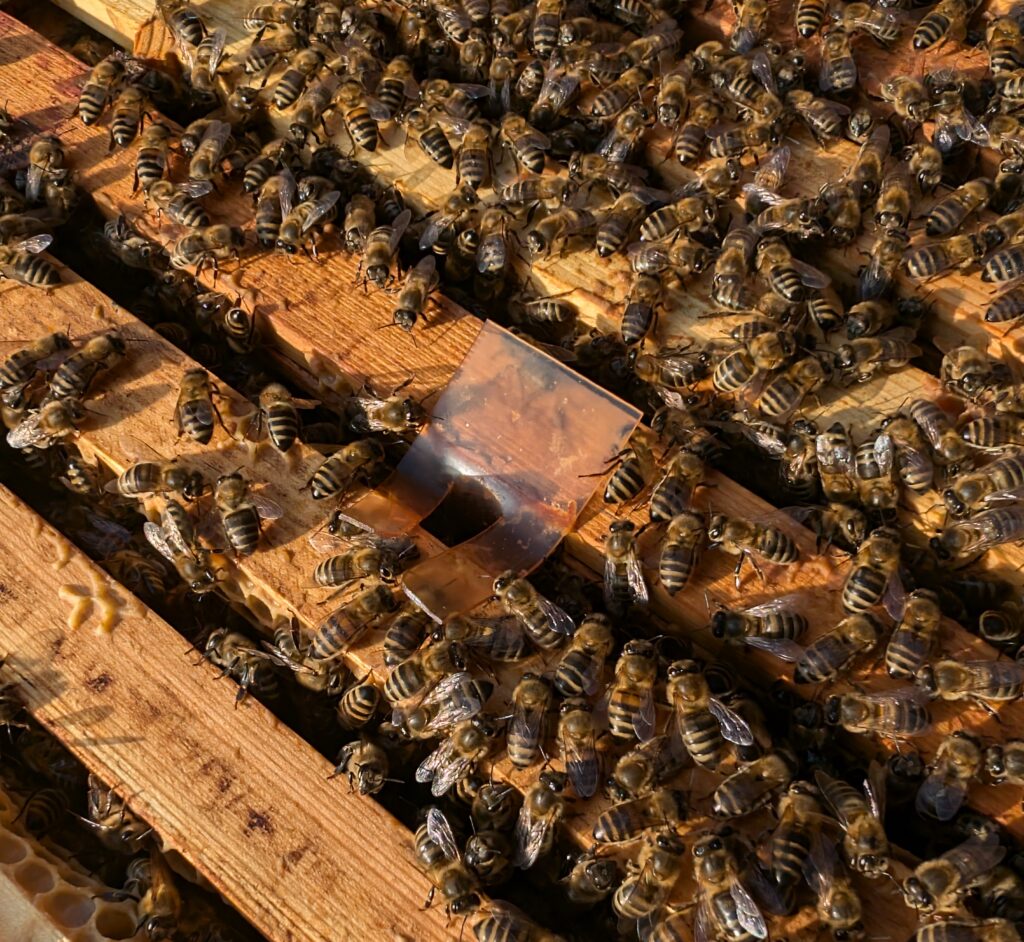Matt’s empire of bees is thriving! April was quite the month.
On 1st April, Matt was caught off guard when he noticed that both of his colonies were bursting out of their hives! Fearing they would swarm, he quickly scrambled to add boxes and frames to accommodate the booming families.
He suspects the fields of oilseed rape that grow near his apiary may have contributed to the bees multiplying with lightning speed. Nutritionally, bees need a varied diet – oilseed rape alone won’t keep them healthy. Still, an abundance of nectar means an abundance of energy. And that means the bees can work efficiently, raising brood fast enough to surprise Matt!
Not only have both of Matt’s colonies been growing and growing but, on 6th April, Matt welcomed another family into his apiary. He purchased the small, sweet natured colony from a fellow beekeeper. This beekeeper had taken an 11-year break and was just getting back into the hobby when they had a severe reaction to a sting. Sadly, it looks like their long break will be continuing. So, Matt adopted the gentle family of bees. Shortly before joining Matt’s other two colonies, they’d received a clean bill of health from a bee inspector. For that reason, Matt felt it was safe to skip the quarantine period that is typically advisable when introducing a new colony to an apiary.
Actual Honey is up to three colonies!
Since a new hive was being added to the site, Matt took the opportunity to install some apiary upgrades. In Matt’s March diary entry, we learned that there was a mould issue in one of the hives. Naturally, preventing that from happening again was his priority. So, he implemented the advice he received from an experienced member of the Harrogate & Ripon Beekeepers Association. Initially, each hive was standing atop a small slab, but the HRBKA member suggested putting down a ground sheet sprinkled with gravel and placing a large paving slab on top of that, which the hive would stand upon. It sounds promising but winter will be the real test. Matt assembled six hive bases using this method, which is the maximum for this apiary site, and three of them are already occupied!
Then there was drama! One of Matt’s colonies felt the additional space added to the hive on the 1st wasn’t enough. Swarm cells had been prepared and charged with larvae. The queen was ready to go! Matt didn’t want to lose his bees so he needed to leap into action. He intended to use Pagden’s artificial swarm method to split the colony in two and satiate their urge to move to a new home. But this strategy requires kit that Matt didn’t have with him.
What do you think Matt should do?
- Destroy the charged cells to slow down the bees and come back in a couple of days with the kit.
- Get the kit and return immediately before it’s too late!
If you chose option 1, you made the same decision as Matt and you were both wrong! If you chose option 2, well done! You have excellent beekeeping instincts.
Matt’s mistake cost him half of his biggest colony. He was gutted, but experience is the best teacher so he will never make that mistake again. And the bees he lost are strong, healthy and mild-mannered which means spreading their genes into the wider population will be valuable to the honey bee species.
At this point, the bees who stayed behind needed to raise a new queen using the charged swarm cells left for them by the departing queen. Matt’s a crafty beekeeper and decided to further split the remaining colony. His thinking was that usually, when dividing a colony, a new queen needs to be brought in or the workers need to raise a new queen from scratch. But, in this case, there was royalty growing right there before his eyes! So, he split the colony into two hives and gave each one a charged cell with a young queen already growing inside.
That means there are four colonies in Matt’s apiary and the promised Actual Honey expansion project is complete!

